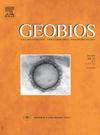揭示旧石器时代中、上古时期埃尔奥利沃洞穴中人类与食肉动物之间的相互作用(西班牙,阿斯图里亚斯,拉内拉)
IF 1.6
4区 地球科学
Q2 PALEONTOLOGY
引用次数: 0
摘要
El Olivo洞穴(西班牙阿斯图里亚斯的Llanera)是Aboño河流域的一个小喀斯特洞穴。它拥有重要的考古和古生物记录,可以追溯到旧石器时代中晚期,在每个考古水平上都有一些石器文物和动物遗骸。对动物遗骸的研究表明,有蹄类动物的代表性很高,鹿和马是主要的动物。食肉动物也以不同的物种为代表,如Vulpes Vulpes和Canis lupus等。地形学分析证明了人类活动的存在,伴随着齿印在所有地层单位和序列下部与水有关的过程的显著发生。在此时间范围内,有人为起源的动物聚集被其他因素,特别是食肉动物的作用所改变。各种各样的食肉动物利用同样的空间,并以人类的残留物为食腐动物。此外,我们认为狐狸表现出一种共生的行为。因此,在伊比利亚北部旧石器时代晚期的遗址中,El Olivo洞穴是探索人类存在水平的食肉动物行为的一个说明性案例。本文章由计算机程序翻译,如有差异,请以英文原文为准。
Unraveling the interplay between humans and carnivores in El Olivo Cave during the Middle and Upper Paleolithic period (Llanera, Asturias, Spain)
El Olivo Cave (Llanera, Asturias, Spain) is a small karst cave within the Aboño River watershed. It holds a significant archaeological and paleontological record dating from the Middle and late Upper Paleolithic, featuring several lithic artifacts and faunal remains in each archaeological level. The study of the faunal remains reveals a high representation of ungulates, with Cervus elaphus and Equus ferus being the main ones. Carnivores are also represented by diverse species such as Vulpes vulpes and Canis lupus, among others. The taphonomic analysis evidenced the presence of human activity, accompanied by a significant incidence of tooth marks across all stratigraphic units and water-related processes in the lower part of the sequence. During this temporal range, there were faunal accumulations of anthropogenic origin altered by the action of other agents, especially carnivores. A diverse array of carnivore used the same space and taking advanced of the anthropogenic residues as scavengers. Moreover, we suggest a commensal synanthropic behavior exhibited by foxes. Consequently, El Olivo Cave is an illustrative case to explore the carnivore action in levels with human presence, something unusual at the late Upper Paleolithic sites in Northern Iberia.
求助全文
通过发布文献求助,成功后即可免费获取论文全文。
去求助
来源期刊

Geobios
地学-古生物学
CiteScore
3.30
自引率
6.20%
发文量
28
审稿时长
6-12 weeks
期刊介绍:
Geobios publishes bimonthly in English original peer-reviewed articles of international interest in any area of paleontology, paleobiology, paleoecology, paleobiogeography, (bio)stratigraphy and biogeochemistry. All taxonomic groups are treated, including microfossils, invertebrates, plants, vertebrates and ichnofossils.
Geobios welcomes descriptive papers based on original material (e.g. large Systematic Paleontology works), as well as more analytically and/or methodologically oriented papers, provided they offer strong and significant biochronological/biostratigraphical, paleobiogeographical, paleobiological and/or phylogenetic new insights and perspectices. A high priority level is given to synchronic and/or diachronic studies based on multi- or inter-disciplinary approaches mixing various fields of Earth and Life Sciences. Works based on extant data are also considered, provided they offer significant insights into geological-time studies.
 求助内容:
求助内容: 应助结果提醒方式:
应助结果提醒方式:


